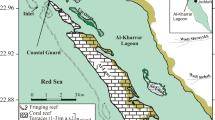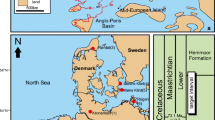Abstract
The first paleoecological reconstruction of the biogeochemical conditions of the Gulf of Batabanó, Caribbean Sea was performed from 210Pb-dated sediment cores. Depth profiles of 20 major elements and trace metals, organic compounds, grain size, and mollusk assemblage composition were determined from 9 stations encompassing unconsolidated sediments in the gulf. Spatial heterogeneity was evident for the geochemistry of sediments and for the mollusk assemblage composition. Our reconstruction indicates that pollution is not a critical threat to the ecosystem, although a slight historical increase of lead enrichment factor was detected probably due to long-range atmospheric fallout. Mollusk assemblages were composed by 168 species belonging to 59 families and no temporal trends in the species diversity or assemblage composition were detected, suggesting no depletion of diversity or habitat loss. Other signals of habitat loss such as changes in organic budget or increase of fine sediment fraction were absent or weak. Nitrogen retained in sediments changed by <1% in the century, indicating no historical events of eutrophication or oligotrophication in the gulf. Historical decrease of fine sediment fraction in the eastern sector would be linked to modifications in sedimentation rate, land use, and/or particle transport from the shelf border; this also suggests that both sectors have different sedimentary dynamics. Although, on theoretical grounds, historical fishery may have caused deleterious ecosystem effects by overexploitation of spiny lobster stocks, no evidence of habitat degradation or loss, caused by fisheries, could be detected.






Similar content being viewed by others
References
Alonso-Hernández, C. M., Diaz-Asencio, M., Munoz-Caravaca, A., Delfanti, R., Papucci, C., Ferretti, O., et al. (2006). Recent changes in sedimentation regime in Cienfuegos Bay, Cuba, as inferred from 210Pb and 137Cs vertical profiles. Continental Shelf Research, 26(2), 153–167.
Alonso-Hernández, C. M., Conte, F., Misic, C., Barsanti, M., Gómez-Batista, M., Díaz-Asencio, M., et al. (2011). An overview of the Gulf of Batabanó (Cuba): Environmental features as revealed by surface sediment characterisation. Continental Shelf Research, 31(7–8), 749–757.
Appleby, P. G. (2008). Three decades of dating recent sediments by fallout radionuclides: A review. The Holocene, 18(1), 83–93.
Arias-Schreiber, M., Wolff, M., Cano, M., Martínez-Daranas, B., Marcos, Z., Hidalgo, G., et al. (2008). Changes in benthic assemblages of the Gulf of Batabanó (Cuba)—Results from cruises undertaken during 1981–85 and 2003–04. Pan-American Journal of Aquatic Sciences, 3(1), 49–60.
Baisre, J. (2010). Setting a baseline for Caribbean fisheries. Journal of Island & Coastal Archaeology, 5(1), 120–147.
Baisre, J., & Arboleya, Z. (2006). Going against the flow: Effects of river damming in Cuban fisheries. Fisheries Research, 81(2–3), 283–292.
Bale, A. J., & Kenny, A. J. (2005). Sediment analysis and seabed characterization. In A. Eleftheriou & A. D. McIntyre (Eds.), Methods for the study of marine benthos (pp. 43–86). Oxford: Blackwell.
Boer, W., van den Bergh, G. D., de Haas, H., de Stigter, H. C., Gieles, R., & van Weering, C. E. (2006). Validation of accumulation rates in Teluk Banten (Indonesia) from commonly applied 210Pb models, using the 1883 Krakatau tephra as time marker. Marine Geology, 227(3–4), 263–277.
Brewster-Wingard, G. L., & Ishman, S. E. (1999). Historical trends in salinity and substrate in Central Florida Bay: A paleoecological reconstruction using modern analogue data. Estuaries, 22(2), 369–383.
Cerdeira-Estrada, S., Lorenzo-Sánchez, S., Areces-Mallea, A., & Martínez-Bayón, C. (2008). Mapping of the spatial distribution of benthic habitats in the Gulf of Batabanó using Landsat-7 images. Ciencias Marinas, 34(2), 213–222.
Clarke, K. R., & Warwick, R. M. (2001). Change in marine communities: An approach to statistical analysis and interpretation (2nd ed.). Plymouth: PrimerE Ltd.
Díaz-Asencio, M., Alonso-Hernández, C. M., Bolanos-Álvarez, Y., Gómez-Batista, M., Pinto, V., Morabito, R., et al. (2009). One century sedimentary record of Hg and Pb pollution in the Sagua estuary (Cuba) derived from 210Pb and 137Cs chronology. Marine Pollution Bulletin, 59(4–7), 108–115.
Dolbeth, M., Cardoso, P. G., Grilo, T. F., Bordalo, M. D., Raffaelli, D., & Pardal, M. A. (2011). Long-term changes in the production by estuarine macrobenthos affected by multiple stressors. Estuarine, Coastal and Shelf Science, 92(1), 10–18.
FAO-WECAFC. (2007). Report of the Fifth Regional Workshop on the Assessment and Management of the Caribbean Spiny Lobster. FAO Fisheries Report, 826. Rome: FAO Western Central Atlantic Fishery Commission.
Ferguson, C. A. (2008). Nutrient pollution and the molluscan death record: Use of mollusc shells to diagnose environmental change. Journal of Coastal Research, 24(supplement 1), 250–259.
Fitzpatrick, S. M. (2010). Viewing the sea from the reefs. Comment and forum synthesis on Julio Baisre’s “Setting a Baseline for Caribbean Fisheries”. Journal of Island & Coastal Archaeology, 5(1), 173–178.
Gaiser, E. E., Zafiris, A., Ruiz, P. L., Tobias, F. A. C., & Ross, M. S. (2006). Tracking rates of ecotone migration due to salt-water encroachment using fossil mollusks in coastal South Florida. Hydrobiologia, 569(1), 237–257.
Gaston, K. J., & Spicer, J. I. (2004). Biodiversity: An introduction (2nd ed.). Oxford: Blackwell.
Haber, W. (2007). Energy, food, and land—The ecological traps of humankind. Environmental Science and Pollution Research, 14(6), 359–365.
Hemminga, M. A., & Duarte, C. M. (1999). Seagrass ecology. Cambridge: Cambridge University Press.
Hoskins, C. W. (1964). Molluscan biofacies in calcareous sediments, Gulf of Batabano, Cuba. Bulletin of the American Association of Petroleum Geologists, 48(10), 1680–1704.
Jackson, J. B. C., Kirby, M. X., Berger, W. H., Bjorndal, K. A., Botsford, L. W., Bourque, B. J., et al. (2001). Historical overfishing and the recent collapse of coastal ecosystems. Science, 293(5530), 629–638.
Long, E. R., MacDonald, D. D., Smith, S. L., & Calder, F. D. (1995). Incidence of adverse biological effects within ranges of chemical concentrations in marine and estuarine sediments. Environmental Management, 19(1), 81–97.
Martínez-Estalella, N., & Alcolado, P. M. (1990). Características generales de las comunidades de moluscos de la macrolaguna del Golfo de Batabanó. In P. M. Alcolado (Ed.), El bentos de la macrolaguna del Golfo de Batabanó. Habana: Editorial Academia.
Nittrouer, C. A., DeMaster, D. J., Mckee, B. A., & Cutshall, N. H. (1984). The effect of sediment mixing on 210Pb accumulation rates for the Washington continental shelf. Marine Geology, 54(3–4), 201–221.
Pham, M. K., Sanchez-Cabeza, J. A., Povinec, P. P., Andor, K., Arnold, D., Benmansour, M., et al. (2008). A new certified reference material for radionuclides in Irish Sea sediment (IAEA-385). Applied Radiation and Isotopes, 66(11), 1711–1717.
Povinec, P. P., Pham, M. K., Sanchez-Cabeza, J. A., Barci-Funel, G., Bojanowski, R., Boshkova, T., et al. (2007). Reference material for radionuclides in sediment IAEA-384 (Fangataufa Lagoon sediment). Journal of Radioanalytical and Nuclear Chemistry, 273(2), 383–393.
Sanchez-Cabeza, J. A., & Ruiz-Fernández, A. C. (2011). 210Pb sediment radiochronology: an integrated formulation and classification of dating models. Geochimica et Cosmochimica Acta. doi:10.1016/j.gca.2010.12.024.
Sanchez-Cabeza, J. A., Masqué, P., & Ani-Ragolta, I. (1998). 210Pb and 210Po analysis in sediments and soils by microwave acid digestion. Journal of Radioanalytical and Nuclear Chemistry, 227(1–2), 19–22.
Sanchez-Cabeza, J. A., Ani-Ragolta, I., & Masque, P. (2000). Some considerations of the 210Pb constant rate of supply (CRS) dating model. Limnology and Oceanography, 45(4), 990–995.
Sanchez-Cabeza, J. A., Pham, M. K., & Povinec, P. (2008). IAEA Programme on the quality of marine radioactivity data. Journal of Environmental Radioactivity, 99(10), 1680–1686.
Surge, D. M., Lohmann, K. C., & Goodfriend, G. A. (2003). Reconstructing estuarine conditions: oyster shells as recorders of environmental change, Southwest Florida. Estuarine, Coastal and Shelf Science, 57(5–6), 737–756.
Warwick, R. M., & Clarke, K. R. (1993). Increased variability as a symptom of stress in marine communities. Journal of Experimental Marine Biology and Ecology, 172(1–2), 215–226.
Willard, D. A., & Cronin, T. M. (2007). Paleoecology and ecosystem restoration: Case studies from Chesapeake Bay and the Florida Everglades. Frontiers in Ecology and the Environment, 5(9), 491–498.
Wingard, G. L., Cronin, T. M., Holmes, C. W., Willard, D. A., Dwyer, G., Ishman, S. E., et al. (2004). Ecosystem history of southern and central Biscayne Bay: Summary report on sediment core analyses – Year two. U.S. Geological Survey Open File Report 2004, 1312.
WWF—World Wide Fund for Nature. (2004). Living planet report. Cambridge: Banson Productions.
Acknowledgements
This work was supported by the International Atomic Energy Agency (IAEA) through the Technical Cooperation Project CUB7/006. We would like to thank the R/V ALECRIN II crew and sampling team: Miguel Gómez, Yanis Cruz, Alexander Lopeztegui, and Rafael Fuentes. Special thanks to Norberto Capetillo and Julio Baisre. We are also grateful to the IAEA Marine Environment Laboratories, specially the Radiometrics Laboratory, and the Project Manager Michel Warnau.
Author information
Authors and Affiliations
Corresponding author
Rights and permissions
About this article
Cite this article
Armenteros, M., Díaz-Asencio, M., Fernández-Garcés, R. et al. Historical changes of sediments and mollusk assemblages in the Gulf of Batabanó (Caribbean Sea) in the twentieth century. Environ Monit Assess 184, 4709–4723 (2012). https://doi.org/10.1007/s10661-011-2296-z
Received:
Accepted:
Published:
Issue Date:
DOI: https://doi.org/10.1007/s10661-011-2296-z




